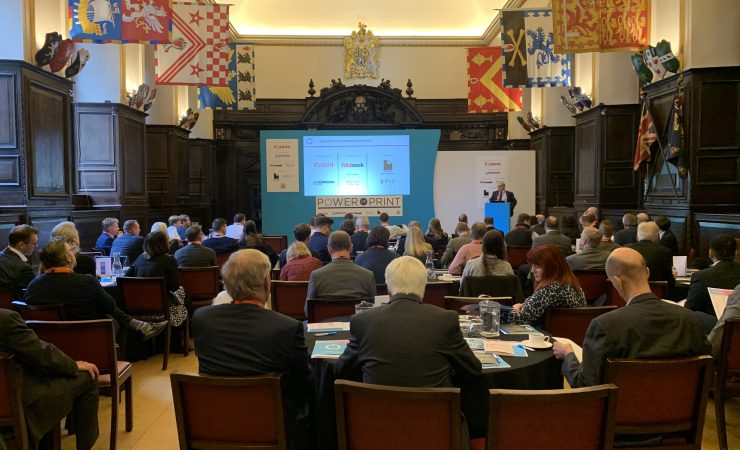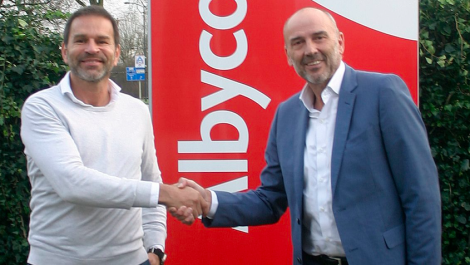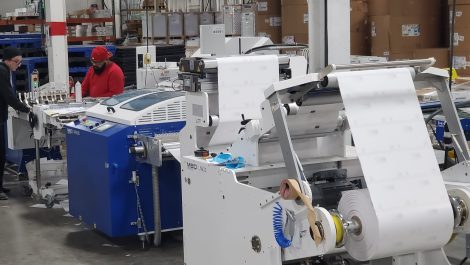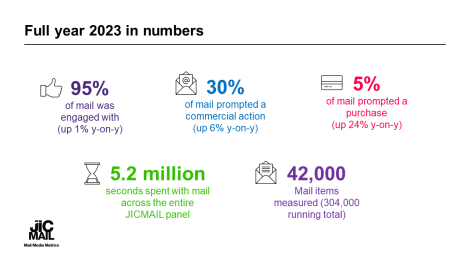The 2023 Power of Print seminar held at Stationers’ Hall in London lived up to its billing, with a wide array of speakers covering topics as diverse as AI, music and creativity, EU regulation, direct mail, Net Zero and packaging.
After opening remarks by Two Sides UK managing director Jonathan Tame, the BPIF’s Charles Jarrold provided an update on the industry’s progress, noting that its net worth had increased from £11.7 billion in 2021 to £13.7 billion at the start of 2023, reflecting a bounce-back from the pandemic period. However, confidence going into the third quarter of 2023 is ‘fragile’ after Q2 failed to meet expectations.
As supply chain issues have improved and confidence is growing that inflation has peaked, top concerns are now around skills shortages and competitor pricing, though energy costs remain high on the list. Packaging and books have held steady as sectors, but the focus for commercial print must now be on data, targeting and analytics, said Mr Jarrold.
The latter point was fleshed out by Mark Davies of Whistl, who suggested that the digital advertising duopoly of Meta (Facebook) and Google is ‘facing its own disruption’ as a result of falling consumer confidence in the veracity of digitally delivered messages, questionable claims about reach and advertising fraud, estimated to be worth some US $100 billion in 2023. Changing privacy regulations and technical implementations will further erode its advantages, he added.
By comparison, Mr Davies said that print is able to provide a ‘pretty decent response’ in terms of transparency and verifiable results, and cited examples of brands that were moving from digital-dominated campaigns to using print, with direct mail seeing its biggest growth in Q2 of 2023 since 2006. ‘Money is moving out of digital and into print,’ he confirmed.
Canon’s wide-format specialist Matthew Faulkner provided an insight into how emotional states play into purchasing decisions and how brands might use a ‘wheel of emotions’ to understand how and when to best tap into this. From this he explored how graphic imagery can affect emotional states and be used positively to enhance indoor environments, building on humans’ evolutionarily hard-wired responses to certain types of landscapes, and connecting this to opportunities for bold design to feature is social media promotion of retail businesses.
More direct mail ammunition followed from Ian Gibbs of Jicmail and the DMA who warned against setting short-term targets at the expense of long-term growth. Speaking about the price sensitivity brought in by cost-of-living worries, he noted that a campaign of continuous discounting and price comparison sensitivity only produces a customer base that expect further discounts, evidenced by a large drop in brand loyalty in 2023.
Mr Gibbs provided some persuasive figures for print’s value as a high attention channel, and demonstrated that when viewed in terms of cost per minute for the attention of an ABC1 consumer, it is competitive with TV and OOH and cheaper than digital channels.
A strong sustainability theme came from Maya Kjellberg of Ikea, who explained how packaging was integral to the Swedish company’s success. She explained how successive rounds of revision and process redesign are driving down materials usage, increasing recycling rates and reducing the amount of single-use plastic, with a figure of 70,000 tonnes across the 468 stores reduced to 41,000 tonnes in 2023 with the aim of being plastic-free by 2028. Innovations such as paper-based pallets instead of the conventional wooden ones have alone saved the company €50 million a year.
Packaging, or forthcoming EU regulations that affect it, was also the topic of the presentation from Anna Papagrigoraki of the Confederation of European Paper Industries, who explained the current and impending legislation that has originated from EU Commission president Ursula von der Leyen’s ‘European Green Deal’ announced in December 2019. Ms Papagrigoraki explained the various current and forthcoming EU Directives that affect packaging, some of which are still being debated, particularly in terms of the use of plastics, with the overarching aim that all packaging should be reusable or recyclable by 2030. Her advice was, ‘This will be coming to the UK in form, so keep your sustainability reporting clear and up-to-date’
Sustainability was also central to the message delivered by Simon Heppner of Net Zero Now, who argued that the initiative is helpful to business’s long term success, including their ability to attract younger workers who value environmental credentials. He explained how mandatory carbon reporting will be extended progressively to smaller businesses and that finance availability and terms are increasingly tied to ESG performance.
Mr Heppner advocated an approach that involves calculating greenhouse gas equivalent for all parts of a business’s operations, including ‘Scope 3’ emissions, which relate to suppliers, then setting targets using the Science Based Targets initiative (SBTi) model. Once actioned, reporting and continuous iteration of the process should follow. Mr Heppner is aiming for industry collaboration to develop print-specific data and advice, having tackled eight other industry sectors.
Mark Shayler of innovation and environmental consultancy Ape presented a musically-oriented take on the enduring tactile and other physical properties of print, interspersing analysis of seminal album sleeves with print campaigns from the 1950s onwards. Espousing print as the ‘quiet’ against the ‘noise’ of digital channels, he contrasted the development and packaging (in both senses) of popular music over the decades with other commercial campaigns, and summarised creativity as the ability to ‘imagine a world that is not here yet’.
One of the most topical presentations was from Henry Coutinho-Mason, consultant and author The Future Normal, who outlined the breakneck pace of development in AI, noting that ChatGPT is less than a year old but has already diversified into several ‘custom’ variants to suit different applications, while Amazon and Microsoft have introduced AI-based tools this year. He suggested that this summer’s call for regulation by the big players was actually a means of shutting down their prospective competitors.
Mr Coutinho-Mason noted that basic human needs and desires do not change, but described a shift towards an ‘expectation economy’, with expectations usually defined by customers’ experiences in other sectors. He gave various examples of AI applications, ranging from programming aids and medical report writing to automated dating site review and setting-up of recommended prospective partners, plus insights into how AI can support a range of roles and tasks, as well as enabling entirely new business possibilities such as a recording artist making a synthesised version of her voice available to fans to produce – and monetise – their own songs.
Wrapping up the proceedings, Two Sides’ Mr Tame updated on the organisation’s membership, now at 600 around the world, and presented highlights from its most recent study, from June 2023. This showed rising concerns over data privacy online and desire for a right to choose between paper-based or online communications. Awareness among consumers of the increasing area of European forests is still very low, however, though improved on previous years. Two Sides’ anti-greenwashing campaigns have reached millions of consumers around the world and the organisation is encouraging retailers and brands to adopt its ‘Love Paper’ branding.





